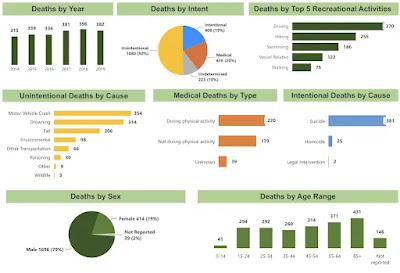The data on the mortality dashboard covers fatality statistics in national parks from 2014 through 2019. According to the NPS, the dashboard helps them identify key trends, such as leading causes of deaths, activities that resulted in a death, and populations that are at greater risk of dying. National parks and programs use the data to prioritize safety projects and prevent injuries. Park managers also rely on this information to plan operations and target resources to save lives. Examples of visitor safety projects include:
* High visibility traffic safety enforcement campaigns
* Preventive search and rescue (PSAR) programs
* Injury prevention campaigns such as drowning prevention, heat safety, safe distance from wildlife, etc.
* Life jacket loaner stations Since the primary topic of this blog is hiking, I wanted to take a closer look at hiking related deaths. Here are several key takeaways:
* A total of 2149 people died in national parks during the six-year time period reported on the dashboard.
* 255 individuals died while hiking (representing 11.9% of all deaths in national parks). Another 75 people died while walking.
* Among those that died while hiking, 73 were the result of a fall, which was the most common cause of death for hikers.
* 50 hikers died as a result of an environmental cause, such as lightning, thermal burns, or exposure to heat or cold.
* Only one person died as a result of a wildlife encounter. The dashboard didn't indicate what type of wildlife was involved, however, this is great news for those with an intense fear of bears. You could argue that this extremely low figure is due to on-going education; meaning, national parks (and others) are doing a great job of promoting ways to avoid surprise encounters and injuries, such as walking in groups, making plenty of noise, and carrying bear spray.
* The overwhelming number of individuals that died while hiking were males (84%). The question that comes to mind, which can't be answered from the dashboard, is what's the ratio between male and female hikers. According to the most recent data I found while researching this topic for my book on the history of hiking, the percent of males (39%) who participate in hiking was significantly higher than females (29.2%). My guess is that this gap has narrowed considerably in recent years. Therefore, the data from the mortality dashboard would seem to suggest that males are significantly more prone to dying while hiking than females. While researching Search and Rescue (SAR) statistics for my book, I found:
The typical victim needing a SAR is primarily a male in his 20s. According to national park data the most common factors that contribute to SAR incidents are fatigue, poor physical condition, insufficient information, error in judgment, and insufficient equipment, clothing or experience. All of these factors would seem to indicate that the majority of individuals needing a SAR are novices. Search and rescue personnel from across the country have noted that many inexperienced hikers are hitting the trail unprepared, and aren’t carrying the ten essentials.* 121 people who died while hiking were older than 55 (47.5% of all hiking deaths). In a likely related statistic, 106 deaths were due to a medical issue.
* In other related outdoor activities, 62 people died while climbing, 11 while canyoneering, 4 while rock scrambling, and 2 while snowshoeing. Another 13 died while camping.
The following are some of the key findings noted by the NPS:
* Out of 420+ national parks, 177 reported one or more deaths in this six-year period.
* An average of 358 deaths a year were reported in this six-year period, or 7 deaths a week. * In 2019, the NPS mortality rate was 0.11 death per 100,000 recreational visits, which is very low when compared to the 715 deaths per 100,000 people rate of the overall U.S. population.
* Most deaths (79%) occurred among males.
* More than half of all deaths (52%) occurred among people ages 45 and older.
* Half of all reported deaths (50%) are due to unintentional causes.
* Motor vehicle crashes, drownings, and falls are the top three leading causes of unintentional deaths in parks, in that order.
* Half of medical deaths (50%) occurred while the individual was engaged in a physical activity (e.g., hiking, biking, swimming).
* Suicides account for 93% of all reported intentional deaths. Suicides are a national public health concern. The objective of collecting and analyzing suicide data is to support an informed discussion about suicides in national parks.
Finally, the NPS noted several common hazards that park visitors should be aware of:
* Severe weather like lightning, blizzards, extreme heat, or cold temperatures
* Wildland fires
* Geologic activities like volcanoes, hot springs, rockfalls, geysers
* Water hazards like rip currents, flooding, rapids, cold water temperatures
* Terrain features like steep slopes, sheer cliffs, waterfalls, sinkholes, high elevations
* Condition of walking surface like gravelly, rocky, wet trails or uneven steps in historic structures
To view the dashboard, please click here.
************************************************************************************
Check out our online trail guides:
- Glacier National Park: HikinginGlacier.com
- Grand Teton National Park: TetonHikingTrails.com
- Rocky Mountain National Park: RockyMountainHikingTrails.com


2 comments:
Can you please include a link where we can find the research you did for Long's Peak?
Kelly - the article above links to that post, but here's the link:
https://rockymountainhikingtrails.blogspot.com/2021/03/a-statistical-analysis-on-fatalities.html
Post a Comment